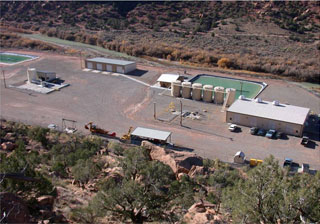Salinity Control Program
Nearly 30 million people in the United States and Mexico depend on water from the Colorado River. In addition, the river water irrigates nearly four million acres of land in the U.S. and 500,000 acres in Mexico. About one-half of the salinity in the river comes from natural sources, and the other half comes from human uses of the water and activities near the river. The threat of salinity is a major concern – it affects agricultural, municipal and industrial water users. Salts dissolved in Colorado River water cause more than $300 million in damages each year.

- How is the CWCB involved in controlling salinity in the Colorado River Basin?
-
The CWCB, in collaboration with the Colorado Department of Public Health and Environment (CDPHE), represents the State of Colorado in the Colorado River Basin Salinity Control Program (CRBSCP). The CRBSCP is a cooperative effort of the seven Colorado River Basin states, the federal government and basin water users to limit increases in river salinity.
- What does the Program do?
-
The Program reduces salinity, preventing salts from dissolving and mixing with the river’s flow. Irrigation improvements and vegetation management reduce water available to transport salts vertically, laterally and on the soil surface. Point sources, such as saline springs, also are controlled. The Program, a long-term interstate and interagency public/private partnership effort, is carried out to reduce the amount of salts in the river and its associated impacts in the basin.
The combined efforts of the Program have resulted in the control of an estimated 772,627 tons of salt per year. This salt reduction results in reduced damages of about $88 million/year.
- What projects are in Colorado?
-
- Grand Valley Unit: Canal lining, piped laterals and on-farm irrigation improvements in the Grand Junction area, funded by U.S. Bureau of Reclamation (USBR) and Natural Resources Conservation Service (NRCS)
- Lower Gunnison Unit: Livestock winter water source replacement, piped laterals and on-farm irrigation improvements in the Montrose and Delta areas funded by USBR and NRCS
- Mancos Area: Piped laterals and on-farm irrigation improvements in the Mesa Verde area, funded by NRCS
- Montezuma Valley Unit: Canal lining, piped laterals and on-farm irrigation improvements in the Cortez area funded by USBR and NRCS
- Paradox Valley Unit: Saline groundwater interception and deep well disposal along the Dolores River near Bedrock, Colo., funded by USBR
- Additional NRCS study areas: Silt, Whitewater and Debeque
Point of Contact
Nora Flynn
303-866-3441 x3215